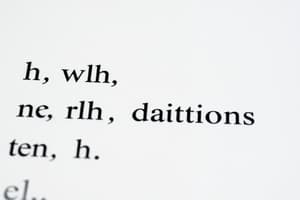Podcast
Questions and Answers
Which part of a tag question comes first in the structure?
Which part of a tag question comes first in the structure?
- Interrogative nature
- Original statement (correct)
- Tag question
- Rising intonation
What is the purpose of tag questions?
What is the purpose of tag questions?
- To seek agreement or confirmation (correct)
- To contradict the speaker
- To emphasize the original statement
- To provide a definitive statement
In a tag question, what type of intonation is typically used at the end of the tag?
In a tag question, what type of intonation is typically used at the end of the tag?
- Rising intonation (correct)
- Falling intonation
- Flat intonation
- Variable intonation
How are tag questions perceived in terms of politeness?
How are tag questions perceived in terms of politeness?
Which of the following words might typically be found in a tag question?
Which of the following words might typically be found in a tag question?
Match the following with their correct description:
Match the following with their correct description:
Match the components of a subject question in English word order:
Match the components of a subject question in English word order:
Match the components of an object question in English word order:
Match the components of an object question in English word order:
Match the pronoun commonly used to begin a subject question:
Match the pronoun commonly used to begin a subject question:
Match the pronoun commonly used to begin an object question:
Match the pronoun commonly used to begin an object question:
Flashcards are hidden until you start studying
Study Notes
Tag questions involve a sentence followed by a tag question that includes words such as "yes," "no," or "don't you." They are often used for confirmation of shared understanding between two parties and can be seen as polite ways to seek agreement.
Structure of Tag Questions
Tag questions follow this structure:
- Original statement
- Tag question
For example, if someone says, "It is raining outside," a tag question could be, "Is it?" In response to this tag question, the person could say either "Yes, it is raining," or "No, it isn't."
The tag question part of the sentence ends with a rising intonation to emphasize its interrogative nature.
Studying That Suits You
Use AI to generate personalized quizzes and flashcards to suit your learning preferences.




